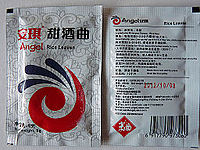
Photo from wikipedia
Medium-temperature Daqu (MT-Daqu), a saccharification-fermentation agent and aroma-producing agent, is used to produce Chinese strong-flavor Baijiu. Many related studies have been published; however, less is known about microbial community and… Click to show full abstract
Medium-temperature Daqu (MT-Daqu), a saccharification-fermentation agent and aroma-producing agent, is used to produce Chinese strong-flavor Baijiu. Many related studies have been published; however, less is known about microbial community and quality properties inside and outside the MT-Daqu from fermentation to storage. Here, along with determining the physicochemical index, the microbial community of MT-Daqu was investigated using both culture-dependent and culture-independent methods during 31 days of fermentation and 4 months of storage. Volatile compounds of mature MT-Daqu were analyzed using headspace solid-phase microextraction (HS-SPME) combined with gas chromatography-mass spectrometry (GC–MS). The results indicated obvious variation in the microbial community due to the changes in environmental conditions, and the physicochemical indices shifted from fluctuations in the fermentation period to relative stability after storage for 3 months. Moreover, the microbial counts and physicochemical indices of the inner layers of MT-Daqu differed from those of the outer layers. The dominant communities, including the bacterial phyla Firmicutes, Proteobacteria, and Actinobacteria and the fungal phyla Ascomycota and Mucoromycota, showed different abundances in the two parts of the mature MT-Daqu, and different microbial communities were enriched in both parts. Additionally, pyrazines and alcohols were the most abundant volatile aroma compounds in the mature MT-Daqu. Graphical Abstract
Journal Title: Frontiers in Microbiology
Year Published: 2022
Link to full text (if available)
Share on Social Media: Sign Up to like & get
recommendations!